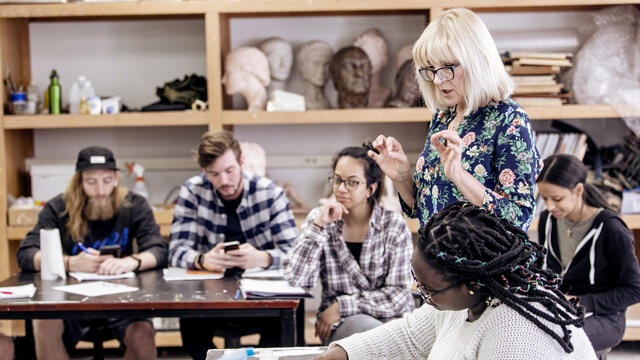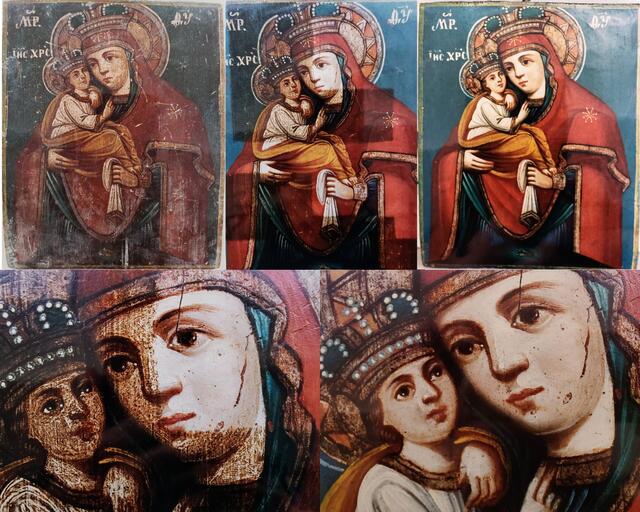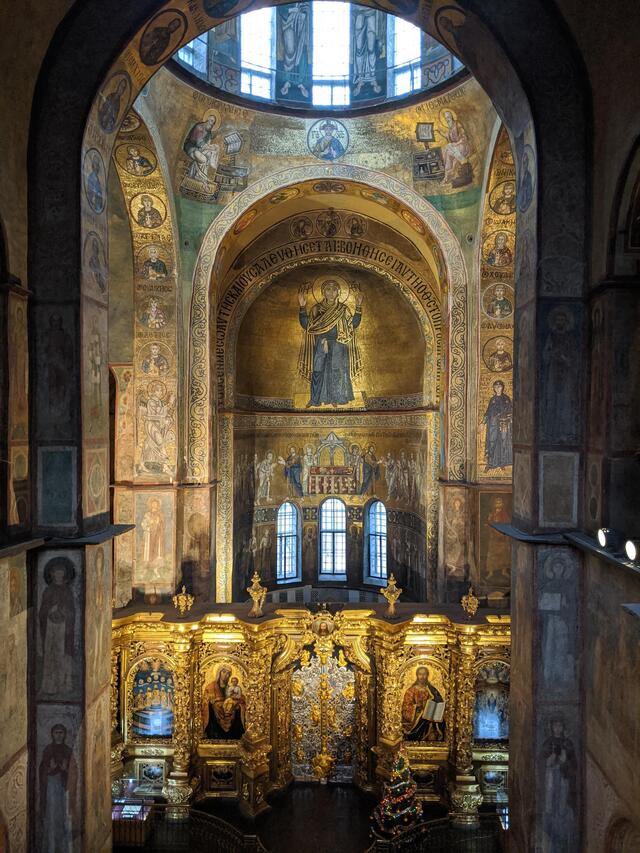Art under siege in wartime Ukraine
Kateryna Dovgan, senior lecturer of Art and Art History, shares her perspective on the endurance of art and culture in Ukraine one year into Russia’s invasion.

Lecturer Kateryna Dovgan spent more than a decade as an artist and art conservator in her home city of Kyiv, Ukraine. She currently teaches courses at McDaniel in studio art and art conservation.
In February 2022, Russia launched an invasion of Ukraine that displaced more than eight million people and has led to tens of thousands of deaths over the past year. Russian occupation and active warfare have destroyed swathes of cities in Ukraine, and the total sum of losses is still unknown.
As the conflict continues, the collateral includes tangible pieces of Ukraine’s culture and history: art, books, artifacts, and architecture. Humanitarian law dictates that museums and cultural centers, like residential areas, should not be targets for missiles strikes, but Russian attacks have been indiscriminate. From day one, conservators have been working to protect archives and stand ready to reconstruct damage.
“Ukrainians are very peaceful, but now they’re fighting like lions and disappointing everyone who thought that they would fall.”
“Right now, the National Museum of Art in Kyiv has some of the oldest iconographic art in Ukraine hidden in its basement,” says Kateryna Dovgan, senior lecturer in Art and Art History.
Dovgan grew up in Kyiv, the Ukrainian capital, among a family of artists. It’s where she began her own career as an artist and art conservator.
“I have friends in Ukrainian cities who work at the museums, and colleagues from my time at the Art Academy in Kyiv, who right away started packing, evacuating, and putting art into basements,” she says. “So, if a bomb falls on the museum, the art will be preserved.”
Dovgan feels the destruction and threat to Ukrainian culture acutely, but not without hope. “Many of the icons in the National Museum of Art hold stories that, in a way, mirror the story of Ukraine,” she says. “They would burn and then get restored and then burn again, and then there would be another coat of gilt.”
Dovgan’s history of restoring the past
In October 1997, a series of churches in Baltimore burned in a string of thefts and arson. One of the targets was St. Michael The Archangel, a Ukrainian orthodox church.
The destruction robbed parishioners of prayer candles, handmade robes, and holy icons that had been with the church since its founding in 1893 by Ukrainian immigrants, who were joined decades later by Ukrainians fleeing Russia during World War II.

Byzantine-style iconography of the Madonna with Child, painted by Dovgan.
The iconostasis, an ornate panel placed between the pews and the altar, was “damaged to the point of no salvation,” says Dovgan. Naturally, the church called her to restore it.
“I used Ukrainian icon styles from the Byzantine and Baroque periods, and they’re still there today,” she says. At the time, she was teaching a course at McDaniel called Painting Techniques of the Past.
“I love history. I love digging into it whenever I have the opportunity. My students also get to do hands-on research, too,” Dovgan says.
In her Basics of Art Conservation course, students painstakingly restore real artwork from a local gallery. The slow process gives them plenty of time to consider the history and significance of the art to the people who have handed it down through generations.
Dovgan has dedicated her career to conserving and restoring art — some damaged from simple neglect, some from intentional destruction.
She holds an M.F.A. from the Academy of Fine Arts and Architecture in Kyiv, Ukraine, specializing in studio art and art conservation. She was among the first graduates of the art conservation program, after her father, Borys Dovgan, encouraged her to pursue the unique vocation. It would help her find a job, he told her.
The field requires knowledge of religious history, microbiology, chemistry, photography, and more, Dovgan says: “To be a full-fledged art conservator, you need to be a good artist, to be able to know colors, anatomy, perspective — everything I teach my students in fundamental studio art classes — in order to evaluate the art and see the reconstruction to the very end.”
And her father was right. She was recruited from her master’s program by the Ukrainian National Center for Art Conservation and Restoration, where she worked for more than a decade before moving to the U.S. in 1994. Some of her work includes restoration of 18th-century portraits that were displayed in the National Museum of Fine Arts in Kyiv.

The restoration process is slow, delicate work. Dovgan has restored icons in private collections, like this 19th-century icon of the Madonna with Child, done in oil paint on unprimed wood.
Ancient art faces modern missile strikes in Ukraine
If you ask Dovgan about Ukrainian iconography, she’ll ask how much time you have. The history of Ukrainian iconography is deep and rooted in Byzantine history. Tracing the path of an iconographic artwork can lead you from the Byzantine Empire to early Ukraine to the 1721 founding of the Russian Empire. Or from Ukraine to Baltimore during World War II.

During her time with the Ukrainian National Center for Art Conservation and Restoration, Dovgan restored the gilded iconostasis and murals in St. Sophia's Cathedral.
Iconography is an enduring example of cultural, religious, and artistic exchange among European nations. And some centuries-old iconography is part of a city’s architecture and can’t be easily moved to protect it from harm, like mosaics in the 11th-century St. Sophia’s Cathedral in Kyiv.
Mosaics that were in fact originally in St. Michael’s Golden-Domed Monastery, also in Kyiv, created in the 12th century. They were hastily removed in 1934 before Soviet authorities demolished the cathedral with dynamite.
In October 2022, Russian missile strikes landed in the heart of Kyiv, not far from St. Sophia’s. At least 19 people were killed, and residential and institutional buildings were damaged, including Taras Shevchenko Kyiv National University, Khanenko Art Museum, T. Shevchenko Museum, and Kyiv Art Gallery.
“One of the bombs fell in the downtown park where my daughter and her friends played when she was small,” Dovgan says.
In response to the October bombing, Ukrainian President Volodymyr Zelensky promised that all would be restored and condemned the destruction, saying, “It’s like this in all the cities of our state — civil, cultural, educational facilities. Who can fight all this? Who can rejoice at strikes on such objects and such land?”
Although the walls of the Kyiv museums were by then bare, with the art locked away for safekeeping, other cities had less time to prepare before the missiles struck. And the threat to cultural materials comes not only from weaponry, but soldiers, too.
“Some cities were captured then left behind by Russians, and when Ukraine captured them back, we found they had looted everything, everywhere,” Dovgan says. “Can you imagine the loss? What was taken of personal art in apartments and homes is still unknown. Anywhere they could get in, if they saw something, they took it.”
Late last year, Russia declared it was annexing the regions of Donetsk, Luhansk, Kherson, and Zaporizhzhia. Although that claim went unrecognized by international authorities, it was alarming news in those territories. Limited time and resources to mitigate danger meant that more lives, as well as heritage items, could be destroyed as the war evolves.
Facing lost history, Ukrainians find strength
When you visit a country, you can stop by a restaurant and try their borscht, Dovgan says, but if you really want to see culture you visit a museum.
“You get to see all those remnants from the past, which are absolutely fascinating and beautiful discoveries. Stolen and looted art needs to be returned,” she says.
“Art has material value, but also historical and cultural value. It’s something that can never be reproduced. If it’s lost, it’s lost forever,” Dovgan says.
“We are basically losing our roots and culture,” she adds. “They loot all they can and take away archeological findings: artifacts, ceramics, metalsmithing, early sculptures — things that show us what old Ukrainian culture looked like. That’s what we nourished, and now it’s gone.”
“Art has material value, but also historical and cultural value. It’s something that can never be reproduced. If it’s lost, it’s lost forever."
In mid-September, just before the October bombing, Dovgan was visiting Kyiv. It had been so lively that she hadn’t noticed the air raid sirens until she descended into the Kyiv Metro and saw people seated on the platforms.
“When you are in Kyiv, you won’t know that there is a war raging,” she says. “There were Czech anti-tank hedgehogs and barriers everywhere, but it was bursting with life and restaurants and youth.”
Dovgan recalls a sense of reclaimed heritage and pride across the city: “This war, in a way, is awakening people’s sense of their Ukrainian spirit. I saw many bright, educated, wonderful young people speaking Ukrainian as their primary language, and it wasn’t that way 20 years ago.”
Ukraine has a long history of resisting Russian interference. Dovgan was in Kyiv’s Maidan Square during the peaceful protests of the Orange Revolution of 2005 and heard explosions during the 2013 Maidan Revolution of Dignity. She has returned to visit every year and, despite the risks of traveling into a wartime country, hopes to return again soon. “I’m very attached to my homeland,” Dovgan says.
She notes that the city center of Odesa, Ukraine, was declared a UNESCO World Heritage site in January. She’s optimistic that steps like that will provide international protections for a culturally rich city under Russian crosshairs for its strategic port.
After UNESCO’s announcement, the mayor of Odesa, Gennady Trukhanov, told UN News that the Odesa Opera House was still showing performances, though the audience can’t be larger than what the bomb shelter can hold. His statement captures the endurance of Ukraine’s cultural landscape.
With Russia’s war continuing, a positive outlook on the resiliency of Ukraine’s people is one way that Dovgan moves forward, a way of wiping away the smoke and ash to reveal the gold beneath.
“Ukrainians are pushing away a malignant force that we have been suffering from for centuries,” she says. “Ukrainians are very peaceful, but now they’re fighting like lions and disappointing everyone who thought that they would fall.”